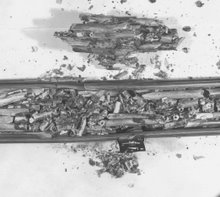Fatal explosion closes cold fusion laboratory
11 January 1992
From New Scientist Print Edition. DAN CHARLES , WASHINGTON DC
Cold fusion researchers are puzzled and worried by an explosion last week that killed one of their colleagues, a British electrochemist. A cold fusion 'cell at SRI International in Menlo Park, California, blew up while Andrew Riley was bending over it, killing him instantly.
According to John Bockris, a researcher on cold fusion at Texas A&M University, small explosions in such cells are common. They occur when oxygen and deuterium, an isotope of hydrogen, combine on the surface of electrodes made of palladium, which catalyses the reaction.
The palladium electrodes are submerged in heavy water. At the top of the cell, they are exposed to oxygen and deuterium vapour, but a film of water usually shields the palladium from direct contact with these gases. Occasionally, says Bockris, a spot on the electrode may dry off, and that may set off a sudden explosion.
Bockris says 30 or 40 such explosions have occurred in his laboratory. In most cases, they forced the top off the steel cell; six times, the bottom blew out. But these explosion caused little damage, perhaps because the palladium wires do not have a large enough surface to catalyse a big explosion.
The explosion at SRI International was far more powerful. Three other researchers apart from Riley were hit by flying debris, including Michael McKubre, who is in charge of SRI's research on cold fusion.
McKubre has been experimenting with cells in which the experiments are kept under pressures of 60 atmospheres. But the cell that exploded, measuring only 5 centimetres in diameter and 20 cm high, was running at normal atmospheric pressure. According to Bockris, who talked to McKubre after the explosion, the cell was not even airtight at the time, so pressure could not have built up slowly inside it.
When firefighters arrived at the scene, they treated the remaining fusion cells in the laboratory like unexploded bombs, says Dennis Maxwell, a spokesman for SRI. The cells were buried in an area normally reserved for hazardous waste, then later retrieved, drained and dismantled.
Inspectors from the California Department of Occupational Safety and Health confiscated the experiment's monitoring equipment. They have sealed off the laboratory until their investigation is completed. When the equipment is returned, McKubre expects to carry out his own investigation.
SRI International's research on cold fusion is funded by the Electric Power Research Institute of Palo Alto, California. Officials at the EPRI refuse to use the term 'cold fusion', however. They say only that they sponsor research on 'excess heat production in electrolytic experiments involving palladium'.
From issue 1803 of New Scientist magazine, 11 January 1992, page 12
Sunday, April 20, 2008
Subscribe to:
Post Comments (Atom)

No comments:
Post a Comment